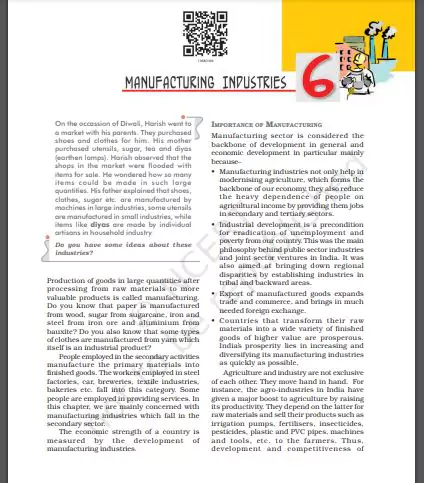‘NCERT Solutions For Class 10 Social Science Chapter 6 Power Sharing‘ PDF Quick download link is given at the bottom of this article. You can see the PDF demo, size of the PDF, page numbers, and direct download Free PDF of ‘Ncert Class 10 Social Science Chapter 6 Exercise Solution’ using the download button.
Manufacturing Industries Book PDF Free Download

Chapter 1: Manufacturing Industries
Production of goods in large quantities after processing from raw materials to more valuable products is called manufacturing. Do you know that paper is manufactured from wood, sugar from sugarcane, iron and steel from iron ore and aluminium from bauxite? Do you also know that some types of clothes are manufactured from yarn which itself is an industrial product? People employed in the secondary activities manufacture the primary materials into finished goods. The workers employed in steel factories, car, breweries, textile industries, bakeries etc. fall into this category. Some people are employed in providing services.
In this chapter, we are mainly concerned with manufacturing industries which fall in the secondary sector. The economic strength of a country is measured by the development of manufacturing industries.
IMPORTANCE OF MANUFACTURING
Manufacturing sector is considered the backbone of development in general and economic development in particular mainly because– • Manufacturing industries not only help in modernising agriculture, which forms the backbone of our economy, they also reduce the heavy dependence of people on agricultural income by providing them jobs in secondary and tertiary sectors. • Industrial development is a precondition for eradication of unemployment and poverty from our country.
This was the main philosophy behind public sector industries and joint sector ventures in India. It was also aimed at bringing down regional disparities by establishing industries in tribal and backward areas. • Export of manufactured goods expands trade and commerce, and brings in much needed foreign exchange. • Countries that transform their raw materials into a wide variety of finished goods of higher value are prosperous. India’s prosperity lies in increasing and diversifying its manufacturing industries as quickly as possible.
Agriculture and industry are not exclusive of each other. They move hand in hand. For instance, the agro-industries in India have given a major boost to agriculture by raising its productivity. They depend on the latter for raw materials and sell their products such as irrigation pumps, fertilisers, insecticides, pesticides, plastic and PVC pipes, machines and tools, etc. to the farmers.
the manufacturing industry has not only assisted agriculturists in increasing their production but also made the production processes very efficient. In the present-day world of globalization, our industry needs to be more efficient and competitive. Self-sufficiency alone is not enough. Our manufactured goods must be at par in quality with those in the international market. Only then, will we be able to compete in the international market?
Contribution of Industry to National Economy Over the last two decades, the share of the manufacturing sector has stagnated at 17 percent of GDP – out of a total of 27 percent for the industry which includes 10 percent for mining, quarrying, electricity and gas. This is much lower in comparison to some East Asian economies, where it is 25 to 35 percent. The trend of growth rate in manufacturing over the last decade has been around 7 percent per annum.
The desired growth rate over the next decade is 12 percent. Since 2003, manufacturing is once again growing at the rate of 9 to 10 percent per annum. With appropriate policy interventions by the government and renewed efforts by the industry to improve productivity, economists predict that manufacturing can achieve its target over the next decade.
The National Manufacturing Competitiveness Council (NMCC) has been set up with this objective. Industrial Location Industrial locations are complex in nature. These are influenced by the availability of raw materials, labor, capital, power, and market, etc.
It is rarely possible to find all these factors available in one place. Consequently, manufacturing activity tends to locate at the most appropriate place where all the factors of industrial location are either available or can be arranged at a lower cost. After an industrial activity starts, urbanization follows. Sometimes, industries
| Author | NCERT |
| Language | English |
| No. of Pages | 16 |
| PDF Size | 2 MB |
| Category | Social Science |
| Source/Credits | ncert.nic.in |
NCERT Solutions Class 11 Social Science Chapter 6 Manufacturing Industries
Question-5
How do industries pollute the environment?
Solution:
Industries have increased pollution and degraded the environment. Industries create four types of pollution mainly air, water, land and noise. The smoke emitted by the industry pollutes the air and water immensely. Air pollution is caused by the presence of a higher proportion of undesirable gases such as carbon monoxide and sulphur oxide.
Source of water pollution are numerous. Most important is the industrial effluent that discharges into rivers. They are both organic and inorganic. They pollute the water. Unwanted loud noise is also pollution. It arises from industries and the different means of transport. Noise causes impairment to hear.
Question-6
Discuss the steps to be taken to minimize environmental degradation by industry?
Solution:
Minimizing the use of water for processing by reusing and recycling it, is done in two or more successive stages.
- Harvesting of rainwater to meet water requirements.
- Treating hot water and effluents before releasing them into rivers and ponds.
Treatment of industrial effluents can be done in three phases:
- Primary treatment by mechanical means.
This involves screening, grinding, flocculation, and sedimentation. - Secondary treatment by biological process.
- Tertiary treatment by biological, chemical, and physical processes. This involves the recycling of wastewater.
NCERT Class 11 Social Science Textbook Chapter 6 With Answer PDF Free Download
